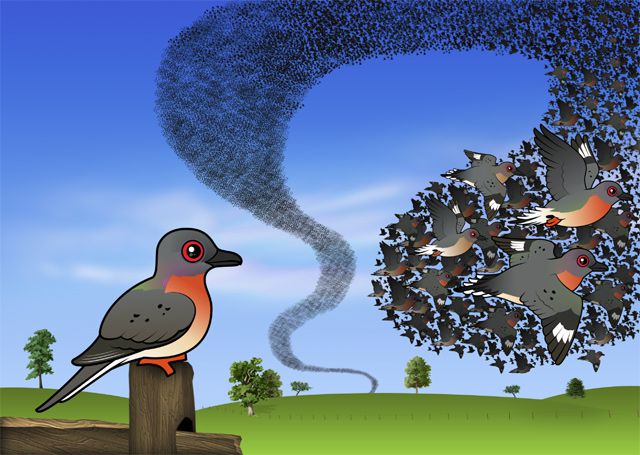Martha Week: 10 Passenger Pigeon Facts
Monday, September 1st will mark the 100 year anniversary of the death of Martha, the last of her species, the Passenger Pigeon. With her death our planet lost another species forever to extinction. This week we'd like to share some of the commemorative events and educational opportunities that are taking place to mark this important centenary.
Passenger Pigeons once ranged across a wide part of eastern North America. Their preferred breeding habitat was deciduous forest; winter roosting sites were either in swamps or pine forests. Here are some more interesting facts about this species.

1) When Europeans first arrived in North America, there were an estimated 3 to 6 billion Passenger Pigeons on the continent. They were certainly the most abundant bird species in North America, and possibly the entire world.
2) Passenger Pigeons could fly 50 to 60 or more miles per hour. They had very strong breast muscles and long wings for strong flying.
3) Passing flocks of Passenger Pigeons would darken the sky and take days to pass an area.

4) Passenger Pigeons were larger than the familiar Mourning Dove. From head to tail they measured 15 to 16.5 inches long and weighed 12-14 ounces.
5) Adult Passenger Pigeons pairs would raise just one chick per year. Both parents would incubate the egg and care for the growing chick.
6) Passenger Pigeon chicks were called squabs (as are other pigeon and dove babies). Fat Passenger Pigeon squabs would fall from the nest before their first flight. The baby would remain on the ground until it was able to fly, usually a few days later.
7) Passenger Pigeons nested in huge colonies, some covering up to 850 square miles or more. A single tree may have held up to 500 nests at one time.
8) Passenger Pigeons dined primarily on nuts: acorns, chestnuts, hickory nuts, and beech nuts.
9) The term "stool pigeon" originates from the culture of hunting Passenger Pigeons. A single captured pigeon would be tied to a stool and then dropped onto the ground. Pigeons flying above the unfortunate captive would take this as a sign to land in the same spot. In this way, entire flocks could be easily captured or shot.

10) After decades of decline due to both over-hunting and rapid deforestation, the last Passenger Pigeon, an individual named Martha, died at the Cincinnati Zoo on September 1, 1914. Her exact age was unknown, but she may have been as old as 29.





Comments
Leave a comment
Thank you!